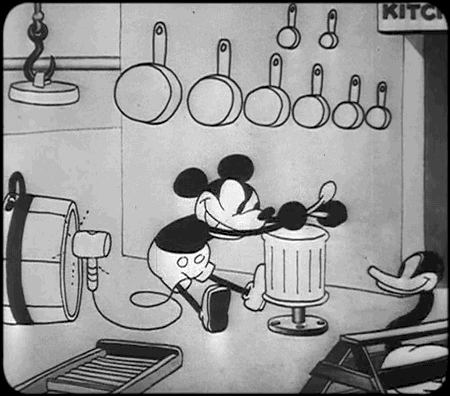Mickey

One in a series of posts dedicated to pop-culture depictions of mice — as symbolic representations of abject other, rebellious scamp, intrepid explorer, scrappy survivor, resourceful collaborator, and habitat experimenter — from 1904–2003.
Walt Disney’s animated Mickey Mouse character debuted publicly in the short film Steamboat Willie (1928). Mickey is piloting a steamboat when Captain Pete comes to the bridge and throws him off. They stop to pick up cargo. Minnie just misses the boat and Mickey uses the crane to grab her. With help from Mickey, Minnie cranks the goat’s tail, and it plays “Turkey in the Straw.”
Mickey accompanies on percussion and by torturing various animals, until Pete comes down and puts a stop to it, putting Mickey to work peeling potatoes. Steamboat Willie won audiences over because it was scored in such a way that the music punctuated the physical motions occurring. Though the practice of synchronizing actions to the rhythm of the music dates back to the days of silent film, within the world of animation this practice henceforth became known as “Mickey Mousing.”
As other MM scholars have noted, we learn from the Nov. 5, 2019 episode (“‘Zip-a-Dee-Doo-Dah,’ Minstrels in Hollywood and The Oscars”) of Karina Longworth’s podcast “You Must Remember This” that Mickey and his friends were associated with America’s blackface minstrelsy tradition thanks to “their big bug eyes and their white gloves, which were often worn in minstrel shows by dandy characters, as a signifier that they aspired to a higher class.” She also notes the use of “Turkey in the Straw” in Steamboat Willie — a song which had since “Zip Coon” become closely associated with minstrelsy. MM’s persona, then, is indebted to that of minstrelsy’s roguish, work-averse, libidinal “coon” character.
America, in the early 20th century, was the source of Fordism — the mass production of standardized goods on a moving assembly line. Mickey is an anti-Fordist homonculus. He serves as a rebuke to standardization, to efficiency. Mickey’s rubbery form made him an emblem of a free-wheeling, fast-thinking, adaptable mode of living — which, during the Depression — must have been extremely attractive. PS: The French famously love American figures — Edgar Allan Poe, Josephine Baker, Sidney Bechet, Jerry Lewis, Philip K. Dick — whose work rebukes, at the level of form, remorseless American-style efficiency. They were early adopters of Mickey Mouse.
Steamboat Willie was followed that same year by Plane Crazy, The Gallopin’ Gaucho, and The Barn Dance. Mickey was a hit, and the short films kept coming.
“There’s a certain animile, making everybody smile. What’s this fellow’s name? Mickey! Mickey! Tricky Mickey Mouse!” — 1930 song by Harry Miles
From 1928 through c. 1933, Mickey Mouse was a rogue, a prankster, sometimes even a jerk. In Mickey’s earliest cartoons, he is 100% concerned with “getting over” — that is to say, doing just enough work to keep from being fired. In his earliest appearances, Mickey drinks beer, smokes, lusts after Minnie Mouse, and lives by his wits. He is petty and vengeful, looking for ways to one-up anyone who annoys him.
Alva Johnston, writing in 1934, noted that although Charlie Chaplin’s Little Tramp character and Mickey may “have the same blend of hero and coward, nit-wit and genius, mug and gentleman,” Mickey lacks “the emotional subtleties of Chaplin, his repose, wistfulness and pathos.” This is a key insight: Mickey was not, at least at first, a sentimental figure. We learn nothing from Mickey, he isn’t inspiring. Writing in 1934, the highbrow novelist E.M. Forster indicates that this is exactly why he likes Mickey Mouse, as opposed to middlebrow cinema: “Here [in the movie theater] art is not, life is not. Not happy, not unhappy, I sit in an up-to-date stupor, while the international effort unrolls.” Mickey, however, is “energetic without being elevating. No one has ever been softened after seeing Mickey or has wanted to give away an extra glass of water to the poor. He is never sentimental, indeed there is a scandalous element in him which I find most restful.”
Maurice Sendak, on MM: “He was a malignant little creature in the beginning, which is why he was so charming.” In a 2004 New York Times interview, Sendak would elaborate: “His character was the kind I wished I’d had as a child: brave and sassy and nasty and crooked and thinking of ways to outdo people.”
For all this talk of scandal, impishness, and wickedness, though, Mickey was also an innocent figure — a childish grownup, one who may smoke and drink but who has somehow avoided becoming resigned to the way-things-just-are. Neither man nor mouse, child nor adult, Mickey is fascinatingly feral.

